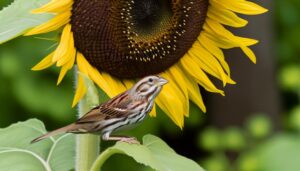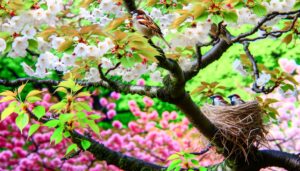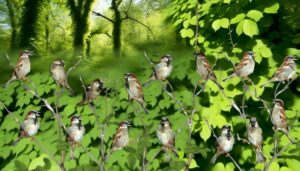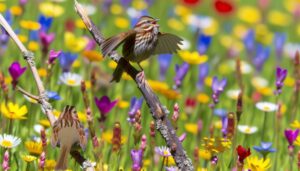5 Key Differences Between Song Sparrow and Purple Finch
The Song Sparrow and Purple Finch are distinct bird species with key differences. Song Sparrows exhibit streaked, brownish plumage and a conical bill, whereas Purple Finches display vibrant raspberry-red hues and a robust bill.
The former prefers ground foraging and dense shrub habitats while the latter favors seeds from coniferous trees and mixed woodlands. Song Sparrows produce varied trills and buzzes, contrasting with the Purple Finch's continuous, melodious warble.
Geographically, Song Sparrows inhabit a wider range across North America, while Purple Finches are more concentrated in northern regions and specific migratory routes. For more intriguing details, continue exploring.
Key Takeaways
- Plumage: Male Purple Finches have vibrant raspberry-red feathers, while Song Sparrows exhibit brown streaks and a central breast spot.
- Size and Build: Purple Finches are bulkier with a robust bill and shorter, notched tail, whereas Song Sparrows are slender with a longer, rounded tail.
- Feeding Habits: Song Sparrows forage on the ground for insects and seeds, while Purple Finches prefer arboreal foraging, eating seeds and berries.
- Nesting: Song Sparrows nest close to the ground in dense vegetation, while Purple Finches build elevated nests in coniferous trees.
- Habitat: Song Sparrows adapt to diverse habitats including wetlands and grasslands, whereas Purple Finches prefer coniferous forests and mixed woodlands.
Physical Appearance
The Song Sparrow exhibits a more streaked and brownish plumage compared to the Purple Finch, which displays a more vibrant combination of raspberry-red hues.
Song Sparrows have a notable array of dark streaks running down their whitish underparts, creating a heavily mottled appearance. In contrast, Purple Finches possess a more uniform coloration with less streaking, especially in males.
Additionally, the Song Sparrow's bill is smaller and more conical, whereas the Purple Finch's bill is slightly bulkier and more robust. Both species share a similar body size, but the Song Sparrow often appears more slender.
The Song Sparrow's tail is longer and rounded, while the Purple Finch's tail is shorter and notched, adding another layer of distinction between these two species.
Plumage Colors
The Song Sparrow exhibits a complex plumage with brown streaks and a distinctive central breast spot.
The male Purple Finch displays vibrant raspberry-red feathers, especially on the head and chest.
Female Purple Finches, in contrast, have more subdued brown and white streaked patterns similar to female Song Sparrows but lack the latter's distinct central spot.
These variations in male and female plumage provide clear visual cues for species identification and sexual dimorphism.
Male Plumage Variations
Male plumage in Song Sparrows typically exhibits streaked brown and white patterns, while male Purple Finches showcase rich raspberry-red hues.
Song Sparrows display a complex pattern of dark brown streaks across a lighter chest and flanks, which provides effective camouflage in their natural habitats. In contrast, the Purple Finch's vibrant red coloration, which often extends from the head to the chest, serves as a striking visual cue during mating displays.
These contrasting plumage characteristics arise from differences in feather pigmentation and structural coloration. The brown and white streaks in Song Sparrows result from melanin, whereas the red hues in Purple Finches are due to carotenoid pigments.
Such distinct male plumage variations aid in species identification and behavioral interactions.
Female Color Patterns
Female Song Sparrows exhibit a more muted palette compared to their male counterparts, with earthy brown tones and subtle streaking providing effective camouflage in their natural environments. Their feathers showcase a mix of grayish-brown, buff, and white streaks, aiding in blending with underbrush. In contrast, female Purple Finches display a more defined pattern with darker, bolder streaks on a lighter brown to white background, offering less camouflage but more striking visual contrast.
| Species | Overall Color | Streaking Pattern |
|---|---|---|
| Female Song Sparrow | Earthy brown | Subtle, fine streaks |
| Female Purple Finch | Light brown | Bold, dark streaks |
Song and Calls
Listening to their songs reveals distinct patterns. The Song Sparrow's melody is a complex series of varied notes, while the Purple Finch's call consists of a rich, warbling tune. The Song Sparrow produces a combination of trills, buzzes, and clear whistles, creating a diverse auditory experience. Each male has a unique repertoire, often used to establish territory and attract mates.
In contrast, the Purple Finch's song features a continuous, melodious warble, interspersed with slurred notes. This rich, fluid series of sounds is less variable than that of the Song Sparrow but equally engaging. Both species use their vocalizations not only for mating rituals but also to communicate presence and assert dominance within their habitats.
Feeding Habits
The Song Sparrow and Purple Finch exhibit distinct feeding habits, influenced by their preferred food sources and seasonal dietary adaptations.
Song Sparrows primarily consume insects and seeds, displaying ground foraging behavior, while Purple Finches favor seeds and berries, often feeding in trees and shrubs.
Seasonal changes notably impact their diets, with both species adjusting their food intake to the availability of resources.
Preferred Food Sources
When it comes to preferred food sources, Song Sparrows mainly consume seeds and insects, whereas Purple Finches prefer seeds, berries, and occasionally small insects.
Song Sparrows have a preference for grass and weed seeds, supplementing their diet with caterpillars, beetles, and spiders. This contrast in diet highlights their adaptability to diverse habitats.
Conversely, Purple Finches mainly consume seeds from coniferous trees and deciduous plants, particularly favoring sunflower and dandelion seeds. Additionally, they're attracted to berries such as mulberries and elderberries, enhancing their nutritional intake.
Unlike Song Sparrows, whose insect consumption is more steady, Purple Finches rely on insects mainly during breeding season. This difference emphasizes their distinct ecological niches and feeding strategies.
Feeding Behavior Traits
In addition to their distinct dietary preferences, Song Sparrows and Purple Finches exhibit unique feeding behavior traits that reflect their ecological adaptations.
Song Sparrows often forage close to the ground, utilizing a hopping motion to search for insects and seeds among leaf litter and low vegetation. This ground-foraging behavior allows them to exploit a variety of terrestrial food sources.
In contrast, Purple Finches display arboreal foraging habits, frequently perching on branches to access seeds and buds from trees and shrubs. Their strong, conical beaks are well-suited for extracting seeds from cones and husks.
These differences in feeding behavior highlight their respective niches, with Song Sparrows primarily exploiting terrestrial resources and Purple Finches adapting to exploit arboreal resources.
Seasonal Diet Changes
Throughout the year, both Song Sparrows and Purple Finches adapt their feeding habits to seasonal availability of food sources, reflecting their ecological flexibility and survival strategies. In spring and summer, Song Sparrows primarily consume insects, such as beetles and caterpillars, while Purple Finches favor seeds and berries, including dandelions and cherries.
During autumn and winter, both species shift their diet towards more abundant resources. Song Sparrows consume a variety of seeds, whereas Purple Finches rely heavily on conifer seeds.
Key seasonal diet components include:
- Spring/Summer:
- Song Sparrows: Insects (beetles, caterpillars)
- Purple Finches: Seeds, Berries (dandelions, cherries)
- Autumn/Winter:
- Song Sparrows: Seeds
- Purple Finches: Conifer seeds
Nesting Behavior
Song Sparrows build their nests close to the ground, often hidden in dense vegetation, while Purple Finches prefer constructing their nests higher up in coniferous trees. This ground-nesting behavior provides Song Sparrows with camouflage against predators, utilizing grass, leaves, and twigs. Their nests are often cup-shaped and well insulated.
Conversely, Purple Finches select elevated sites, which reduce predation risks and allow for better surveillance. They use twigs, grasses, and roots to form loosely woven, open-cup nests. Both species exhibit site fidelity, returning to familiar nesting areas annually.
However, the Song Sparrow's choice of dense, low vegetation contrasts sharply with the Purple Finch's arboreal preference, highlighting their differing strategies for reproductive success and offspring protection.
Preferred Habitats
Both Song Sparrows and Purple Finches exhibit distinct habitat preferences that reflect their adaptive strategies for survival and reproduction. Song Sparrows thrive in a variety of environments, from marshes to grasslands, indicating their ecological versatility. They favor areas with dense vegetation, which offers ample cover and food sources.
Conversely, Purple Finches show a strong preference for coniferous and mixed forests, where they nest and forage.
Key habitat preferences include:
- Song Sparrows:
- Dense shrubs and undergrowth
- Wetlands and marshes
- Grasslands
- Purple Finches:
- Coniferous forests
- Mixed woodlands
- Suburban areas with ample trees
These habitat choices highlight the differences in their ecological niches and resource utilization, allowing each species to thrive in its preferred environment.
Geographic Range
Observers note that Song Sparrows have a widespread geographic range across North America, whereas Purple Finches are more concentrated in the northern regions and specific migratory routes.
Song Sparrows inhabit diverse environments from Alaska to Mexico, adapting to various ecosystems such as marshes, grasslands, and urban areas. This adaptability allows them to thrive in varying climates and altitudes.
In contrast, Purple Finches primarily breed in the boreal forests of Canada and the northeastern United States. During winter, they migrate to the southeastern U.S., showcasing a more defined migratory pattern. Their preference for coniferous forests and semi-open areas influences their geographical distribution.
This comparative analysis highlights the Song Sparrow's extensive adaptability versus the Purple Finch's more specialized range and migratory behavior.
Conclusion
Essentially, the song sparrow and purple finch, though both small and melodious, are as different as night and day. The song sparrow's patterned plumage and intricate song contrast sharply with the purple finch's colorful hues and straightforward melodies.
Their unique feeding habits, nesting behaviors, and habitat preferences further distinguish them. These special characteristics guarantee each occupies a unique niche in the ecosystem, highlighting nature's elaborate tapestry of avian diversity.






